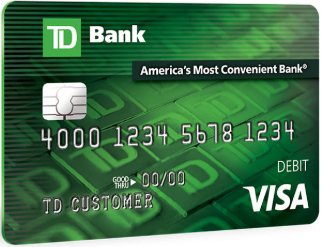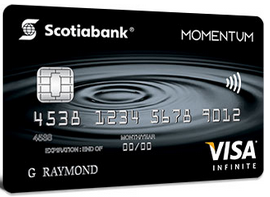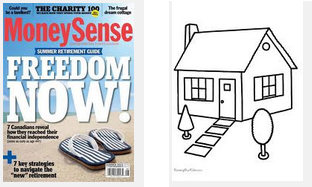 Canada is on the north border of USA; Canada's main export destination is USA; Many Canadians travel to the US on a regular basis. Those all are the reasons why almost every Canadian needs a US dollar bank account. People can find USD accounts in most Canadian banks, including both chequing and savings. But the USD is settled in Canada. They do not participate the clearing among US banks. If you deposit a Canadian-bank-issued USD cheque in USA, the transaction might not get through. Even the financial institute accepts that cheque, it could be subject to hold up to one month! Here is another reason why you may need a US based bank USD account: Paypal Canada can hold both CAD and USD balances in the account. But it only transfers USD to and from a US-based bank account. Even your account in a Canadian bank is of USD, Paypal just does not allow that. Usually your earnings from the internet is dominated as USD. Then you need to convert USD to CAD then withdraw. The conversion rate is not that good in Paypal. People can use his/her Canadian address to open an account in US based banks. Preferred way is to go to a border town. Many Canadians have opened their US accounts there. The staff in border towns gained experience to handle this situation. The forumers usually wrote "smooth" experience online. If you do not want to step into USA and still wish a US account, this is still possible. You may consider subsidiaries of Canadian banks, such as RBC, TD, and BMO. I opened a BMO Harris checking account online. In US they call it checking account, while in Canada, chequing. It has the option of being a Canadian. So the form asks for SIN, instead of SSN. The opening money of USD 100 was billed onto my Canadian credit card. In a few weeks, I received debit card and starter check book (20 pieces of checks) by mail. Then I phoned them to setup the online banking. I should mention the monthly account fee of $12. But by keeping the balance of over $1000, or depositing at least $500, one can waive that fee. (Note: In 2017 they have Smart Advantage Checking account. I switched to this type which requires 0 minimal balance.) I also checked TD Bank (Based in US) offerings. Their minimal balance to waive the monthly fee is only $100. But it seems that TD Bank account online opening only applies to US residents. In Canada one should call cross-border specialist to open the account. I'll do it soon because good things (little min balance) won't exist forever. RBC's cross-border account is the worst among them. It demands $2.95 per month and no ways to waive it. (Update: I called TD cross-border hotline to open my check account. They checked my Canada credit profile in the phone call process. Later I found TD Bank online opening accounts for Canadians. Maybe they have improved their computer system.) Below is the Chinese version. You miss nothing even if it is not displayed in your web browser. 加拿大地缘接壤美国,在经济上强烈依靠美国,这就是为什么加拿大人都需要一个美元户头。在加拿大营业的银行,都有美元的户头,包括 chequing and savings. 可是,加拿大银行的美元户头,只能在加拿大境内清算,不直接参与美国银行间的清算。在美国花一张加拿大银行的美元支票,有可能被拒。即使被接受,也可能至少被 hold 一个月。(my god!) 还有一个理由给为什么要在基于美国的银行开美元户头:paypal canada 只处理加拿大元的加拿大银行账户。即便你在加拿大银行的账户是美元的,也不能加到 paypal 里。如果你有网络广告收入,通常是美元单位。每次转成加元提取,白白被 paypal 克扣转换费。(my god!!) 用加拿大地址是可以在美国的银行开户的。首选办法是去美加边境的小镇,很多加拿大人在那里开过户了,所以他们也有经验了。网上见到的评论通常是 smooth (顺利). 如果不去美国境内,可以考虑加拿大银行在美国的子银行,如 RBC, TD, BMO. 我是在 BMO Harris 开户的,申请材料在网上填写,预存的100美元从我的加拿大元信用卡扣取。很快,从美国寄来第一本免费的支票本,还有 debit card. 我打电话去设置好 online banking. 然后寄了一张支票去我们公司指定的股票经纪商。我们公司在美国上市,所以股票经纪是美国的,它只接受美国银行的账户转账。否则,卖了股票取钱的话,要么寄支票,要么电汇。这个 BMO Harris 户头要最低余额1000美元,否则有每月12元管理费。(如果该月有至少500美元的存入,则也可免去管理费)(2017年注:它推出了 Smart Advantage 支票户头,无最低余额要求,选 eStatement 则可以全部免费。) TD 是最便宜的支票户头,最低余额只需100美元。它不提供网上申请,需打电话去开户。RBC 则不被我喜欢,它没有最低余额要求,每月 2.95 美元管理费,合每年约 36 元。RBC 在加拿大的分行可以接受开户。BMO Harris 的 1000元,每年按 1% 利率计算,成本约 10 元。若将来利率升高,则相当于成本上升。所以,要尽快开 TD Bank 的支票户头,趁它现在还只需100元的最低存款。(更新:我已打电话开了 TD Bank 支票户头。后来我发现它的网站也可以申请开户头了。也许他们提升了系统。我的 BMO Harris 已变更为 Smart Advantage. 免费的。) 为了吸引回头顾客,商家们通常都会搞一个 points program。消费多少钱,给一点积分。 攒够了积分,换点东西,或抵下次消费的钱。在新加坡时,我好像只参加了 link points,它是我们经常去买东西的超市 NTUC FairPrice 领衔的,另外还有一些小商家也参与。总的回扣相当于 1%。 别的较大规模的超市也有类似积分,但是我少去买东西,所以没有去了解。
加拿大的主要积分项目有几个,也都是某个超市在背后支撑。 Air Miles: 主要商家有 SAFEWAY, 银行有 BMO, 油站有 SHELL. 回扣额相当于 0.5%. 但是一个积分相当于 10 cents, 所以每20元才获一个积分,不足20元的零头都被忽略了。算下来,回扣比率远小于 0.5%. PC Points: 这个是 Canadian Real Superstore 支持的,PC Financial 也授予此积分,回扣比率相当于 0.5%. Petro Points: Petro-Canada 油站的积分,回扣只有 0.35%. 消费3000元,得 15,000分,值10元。 最抠门的就是 More Rewards. 消费6000元,得6000分,值10元,算下来回扣比率小于 0.2%. 最慷慨的是 Plum Rewards, 这个是书店的,回扣率高达 1% 到 2%。 可惜我不怎么买纸质的书了,此等回扣享受不到。 In Canada we call a chequing account, while in US, checking. Despite different names, they are much similar in many ways. In order to be efficient, banks usually charge a monthly fee for maintaining chequing accounts, or, you keep more than minimal balance (1 to 2 thousand) to waive the fee. In last decade, the Internet has changed how people live. It has changed how people do the banking too. Many financial institutions set up virtual or direct banking divisions. It does not require brick-and-mortar branches. All the transactions are done electrically. The savings on physical presence are passed to customers in forms of high interest rates, no monthly maintenance fee, and so on. In Canadian market, my favorites are as following:
No. 1. President's Choice Financial. It has pavilions in "Real Canadian Superstores", where you can actually talk to bank staff. They may help you open accounts, setup online banking, etc. Though they do not take deposits or withdrawals. All the checquing and savings accounts are free. Best feature is: all the cheque books are free too. (In 2017 CIBC and President's Choice discontinued cooperation. The CIBC direct financial division changed its name to Simplii Financial and closed pavilions in superstores.) No. 2. Canadian Direct Financial. It offers free chequing and savings accounts. First cheque book is free and additional is chargeable. Best feature: its savings account interest rate is the highest, currently sitting at 1.75%, while President's Choice only 1.05%. Be aware of the catch: while transferring from Savings to Chequing is totally free, other forms of debits on Savings are free only once per month. All the debits on Chequing is absolutely free. No. 3. Tangerine. This one is much similar to the President's Choice. Best feature: it offers electrical verification when adding external accounts. When adding other financial institution accounts, Tangerine will do TWO small deposits to that account. After 2 to 3 business days, the two deposits show up in other financial institution's online banking. Then you key them in Tangerine online banking to complete the adding process. That's it. No. 4. Some local credit unions offer free chequing accounts too. 加拿大的银行称支票户头叫 Chequing, 与美国同行的称呼 Checking 不同,但是做法上有很多共同点。为了减少低余额的户头占用银行资源,银行通常会收取管理费,每个月几元到几十元不等。或者余额达到一定数量(通常一两千元)就可以免除每月的管理费。 Internet 的兴起让 纯 online bank 有了可能。这些 online banks 没有实体分行,所以能减少费用。无实体分行,给需要柜台服务的客户添了一些麻烦,正好靠免除管理费来弥补。愿意靠 internet, ATM 来处理账务的人,就可以享受免费的支票户头了。在加拿大,常见的有: 1. President's Choice Financial. 这个为首选,因为它依托 Real Canadian Superstore, 有广大的超市网络。在超市里设有亭子。开银行户头要填表,所谓 paper work, 怕麻烦的话,就去亭子请工作人员填写。之后,开通网上银行,转账、付款在网上银行进行;取现金到ATM. 它还有一个独一无二的特点:它所有的支票本都是免费 order. 2. Canadian Direct Financial. 它是加西银行的 Direct Banking 部门。开户就得自己网上填表,或者打印、填好,寄去,没有面对面的工作人员服务。它的第一本 cheque book 免费,之后要收费。好在现今社会用到支票的机会不多,一本可以用好久。它的最大好处是,再开一个储蓄户头,储蓄户头的利率目前最高,1.75%。 储蓄户头与支票户头之间转账算内部转账,免费。特别注意:从储蓄户头取现,或者转去其它银行,每个月只免费一次。从第二次起要收费。 3. Tangerine. 这是以前的 ING Direct. 号称给加拿大银行带来革命的虚拟银行。现在的 owner 是五大银行之一的 Scotiabank. 它目前吸引我的特色有:用手机给支票照相就可以存支票;添加其它银行户头,靠存两次微小的转账,然后验证这两次的数额,即可。其它银行添加 external bank, 还需寄去 void cheque. 一来麻烦,二来无法添加储蓄户头。Tangerine 可以添加它行的储蓄户头。 4. 一些信用社 credit unions. 如 coast capital savings. Manitoba 有很多信用社开立了 online bank divisions. 全加拿大(除法语省)的居民都可以申请。缺点是,它们的存款不是 CDIC 公司保险,是另外的公司。优点是保险额度是无限的,不仅仅像 CDIC 的首十万受保险。 加拿大有一个很好的理财杂志 money sense. 我喜欢看其中的 family profile 分析。看得多了,我几乎能掌握典型的加拿大家庭的财务状况。以下就是他们的数字:
家庭收入 Total income : 11万 至 14万 110,000 ~ 140,000. 税及扣款 Taxes and deductions : 41,000. 可支配的收入 Net disposable income : 70,000 ~ 100,000. 他们通常有一项支出: credit card/ line of credit payment 信用卡利息. 基本是每年 6000. 这是我不喜欢的。要是我的话,这两项的利息支出为零。 住房开支: 房贷还款 Mortgage: 16,000 ~ 28,000. 房屋保险 Home Insurance: 400 ~ 800. 房屋维修 Home maintanence: 500 ~ 2,000. 水、电、燃气 Utilities: 3,600. 每月 per month 300. 电话、上网、电视 Phone/internet/TV: 1,800 ~ 2,400. 每月 per month 150 ~ 200. 交通开支: 汽车贷款 Car loan: 3,000 ~ 5,000. 有的要豪华,每年可到1万。 保险 Car insurance: 1,600 ~ 2,800. 汽油 Gas: 2,500 ~ 5,000. 维修 Maintenance: 200 ~ 2,000. 其它: 食物 Groceries: 6,000 ~ 10,000. 衣服 Clothes: 1,000 ~ 3,000. 出外就餐 Restaurants: 1,000 ~ 2,000. 度假 Vocation: 3,000 ~ 10,000. 算下来之后,余钱很少。养老方面,政府有 CPP, OSA. 大多数家庭购买 RRSP. 有些给孩子买 RESP. 还有的买一些保险。有些人贷款去供 RRSP. 据说是合算的。  银行将“账户”称为产品。每过一段时间,银行将“事多钱少”的产品取消,然后称其 "not on sale"。 以前开的户头,银行一般会继续维持,虽然条款里有写“银行有改变任何条款”的权利。不过这种事情有例外,有的银行就会降低现有客户的利益:TD 2011年收购 MBNA 信用卡后,将现有的客户的 cash back benefit 降低,2% 回扣的上限由600元降为400元。消费者只能用脚投票了:改用其它的信用卡。 经过一番上网查询,Capital One 的 1.5% cash back 被隆重推荐。它要求收入在6万以上,信用良好。这不是问题。我于2013年3月申请了。前几日(2013年11月)浏览网页,有人说,这个1.5%的卡不再接受新用户。我去它网站看了一下,果然如此。现在它只有 1.25% 回扣的信用卡了。不过,1.25% 仍比其它卡的 1% 强。我这个 1.5% 的卡算是赶上机会了。(再次更新:其回扣只有 1%。) 以前我都只看 no annual fee 的卡,因为即便不用,也不是负担。网上有人推荐4% cash back on groceries and gas (每年上限花费2万5千回扣) 的卡,年费99元。我算了一下,我家花在食品的钱很多,怎么也有12,500元,合回扣500元。扣去年费,仍有401元。如果这些花费都记在2%的卡,也只有250元。所以,我的生活方式用这4%的卡合算。是为 SCOTIA Momentum 卡。于是我的最佳搭配是:食品与汽油用 SCOTIA, 4% 回扣;其它的花费一律用 1.5% 的 Capital One. Bank accounts are called "products" by banks. From time to time a bank can issue different products to target new group of customers. They may also review existing accounts. If they think one is not too profitable, it is put to "not-on-sale" (no new accounts can be opened). Banks have reserved rights to modify any conditions or benefits of any account, though it is normal practice not to change for existing customers' accounts. I knew one exception example: in 2011 TD bank acquired MBNA credit cards portfolio, then quickly cut the cash-back benefit of all accounts, no matter new or existing. The 2% cash back spending limit decreased from $600 to $400. As a small customer, I can only vote with my feet. Go for other credit cards. After some research through internet, one card caught my eye: Capital One 1.5% cash back Master Card (in above picture). It does not carry an annual fee. But it does require good credit history and annual income above 60,000. I applied it in March 2013. A few months later, I noticed some forums mentioned this 1.5% cash back card was out of market. I checked it out in its website and found the news was true. In Nov 2013, 1.25% cash-back was still on sale. Recently, even 1.25% card has gone. So, if you think you have a good deal, seize it before it is too late. I was particularly interested in no-fee credit cards. Even you do not use it, it will not cost a penny to carry. But I changed my mind when I saw a 4% cash back card with an annual fee of $99. Those 4% rebate only applies to grocery and gas expenses. That fits into my family. We spend lots of money on food and gas, exceeding $12,500 per year. So, the rebate is $500. After $99 fee, it is still worth $401. Even if all of it was put on 2% cash back card, the bonus is only 250. This card fits into my current life style. It is "Scotia Momentum" visa card (also in above picture). My best strategy will be: use Scotia to buy grocery and gas, Capital one for all others. |
AuthorI settled down in Vancouver 8 years ago. Like all the immigrants who come to Canada to pursuit a new life in this free and strong land, I am especially interested in financial products. I believe, by using proper bank accounts, we can greatly enhance our financial lives. Archives
September 2017
Categories |



 RSS Feed
RSS Feed
